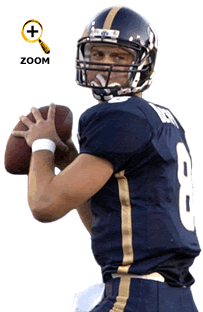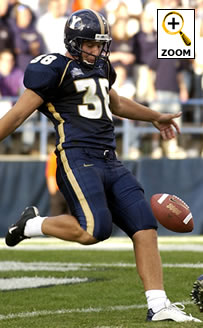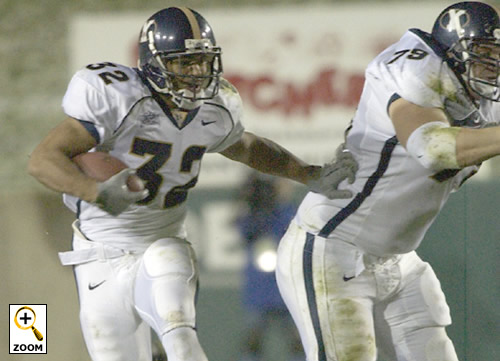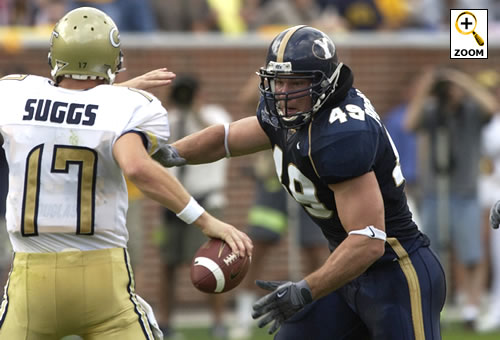 |
| QB
Matt Berry |
|
|
|
2002
Statistics
|
Coach:
Gary Crowton
17-9,
2 years |
|
2002
Record: 5-7
|
|
| SYRACUSE |
WON
42-21 |
| HAWAII |
WON
35-32 |
| at
Nevada |
LOST
28-31 |
| at
Georgia Tech |
LOST
19-28 |
| at
Utah State |
WON
35-34 |
| at
Air Force |
LOST
9-52 |
| UNLV |
LOST
3-24 |
| at
Colorado State |
LOST
10-37 |
| SAN
DIEGO STATE |
WON
34-10 |
| WYOMING |
WON
35-31 |
| NEW
MEXICO |
LOST
16-20 |
| at
Utah |
LOST
6-13 |
|
2002 Final Rankings
AP-UR, Coaches-UR, BCS-UR
|
|
2003
Outlook
|
|
The
2002 Cougars hurt themselves the worst.
They had 35 giveaways, averaging almost
three-a-game in ranking 83rd in I-A TO margin.
And 65 yards-per-game in penalties certainly
didn't help. It is going to be a tough,
but not impossible, task to get this team
to finally gel. They have a hard schedule
that includes games against seven 2002 bowl
teams. Their path is highlighted by road
games at USC and Notre Dame, with Boise
State, Colorado State (play toughest on
the road) and Air Force all in Provo.
In
today's harsh world of "what have you
done for me lately", Gary Crowton is
going to have to produce a winning season
and a bowl team in 2003 if he wants to stay
off the hot seat. It seems that in coaching,
the worst way to go is to start off with
a bang and slowly digress to complacency
(ask Bob Toledo, Gerry DiNardo, etc.). It
reflects poor recruiting, to say the least.
Utah may not be a deep football well from
which to pull, but still…
The
return of 15 starters and both kicking positions
indeed bodes well on all these levels. The
key to their success will undoubtedly be
stable QB play. In all of BYU's successful
campaigns, there has been a stellar QB.
Whether it's Berry, Mortenson, Pendleton
or Beck, someone will need to emerge and
take control. If you look at coach LaVell
Edward's last season at BYU, multiple QBs
caused their 6-6 record. The following season,
in Gary Crowton's first year, they stuck
with Brandon Doman and the team finished
11-2. Similarly, finding QB stability will
give identity to the offense and establish
cohesion as they incrementally achieve steps
and goals. Put your money on Matt Berry
to take charge and team with Toby Christensen
for one of the nation's more potent QB/WR
tandems.
Defensively,
the Cougars should be sound once adept in
their new schemes. Changes in overall approach
fit well with the existing personnel. This
experienced-yet-new-look 3-3-5 squad will
be tested early, with games against explosive
offenses (Boise State, USC and Stanford)
making their learning curve steep. Look
for this group to be extremely aggressive
and use their speed accordingly. The key
is going to be blitzing unpredictably, yet
often, to put pressure on opposing QBs and
force TOs into the hands of many capable
DBs.
Gone
are the days when a BYU team will come out
of nowhere to throw wrenches into the national
polls. This is a building year, but sometimes
building years can explode into bigger things.
Realistically, the Cougars will muster no
more than 9 wins. And, with some team chemistry,
they can even stay neck and neck in their
conference race. They'll advance to a bowl
game (after a year's hiatus) but without
the MWC crown. But take notes, because what
you see this season will surely be the building
blocks (offensively) for what will be an
even better squad in 2004. Maybe not what
the Cougar faithful want to hear now, but
bank on this info to help in any polls you
enter.
Projected
2003 record: 6-6
|
|
 |
| P
Matt Payne |
|
|
|
SPRING
MVP
DB Aaron Francisco
|
|
CO-OFFENSIVE
MVP
QB Matt Berry
WR Chris Hale
|
|
DEFENSIVE
MVP
DE Brady Poppinga
|
|
TOP
NEWCOMER
FB Tafui Vakapuna
|
|
|
|
|
BRIGHAM
YOUNG
*POWER RATINGS
|
|
Offense
|
Defense
|
| QB
- 4 |
DL
- 3 |
| RB
- 3.5 |
LB
- 3 |
| WR
- 3 |
DB
- 3.5 |
| OL
- 2.5 |
.. |
|
|
RETURNING
LEADERS
|
|
Passing:
Matt Berry, 184-108-9, 1309 yds., 7 TD
Rushing: Marcus Whalen, 181 att.,
918 yds., 6 TD
Receiving: Toby Christensen, 30 rec.,
346 yds., 2 TD
Scoring: Matt Payne, 13-16 FG, 27-30
PAT, 66 pts.
Punting: Matt Payne, 51 att., 47.6
avg.
Kicking: Matt Payne, 13-16 FG, 27-30
PAT, 66 pts.
Tackles: Paul Walkenhorst, 107 tot.,
47 solo
Sacks: Brady Poppinga, 8 sacks
Interceptions: Kip Nielsen, 3 for
50 yds.
Kickoff returns: Curtis Brown, 9
ret., 19.8 avg.
Punt returns: David Christensen,
8 ret., 10.0 avg.
|
|
|
|
|
|
|
OFFENSE
- 5
|
----RETURNING
STARTERS----
|
DEFENSE
- 10
|
|
|
KEY
LOSSES
|
| OFFENSE:
Andrew Ord-WR, Reno Mahe-WR, Spencer Nead-TE,
Dustin Rykert-OT, Ryan Keele-OG, Isaac Herring-OT,
Bret Engemann-QB (NFL) |
| DEFENSE:
Jeff
Cowart-DE |
|
|
|
2003
OFFENSE
|
|
written
by Tim Chapman
BYU
played four QBs last season and three of them
return. Someone has to emerge from this pack.
The leader appears to be soph. Matt Berry, who
took over for Brett Engemann as the starter in
the seventh game against UNLV. Berry shows a promising
arm, he is your current leader for the job. The
knock against him, though, is he needs to improve
his decision-making. In the seven games he played,
Matt threw nine INTs against only seven TDs. If
he does not deliver, look for junior Todd Mortensen
to push the envelope. Todd is a very intelligent
signal caller with enough experience under his
belt to make the competition that much better.
He has seen action as a backup over the past two
seasons. Freshman QB Ben Olson announced that
he plans on serving a two-year LDS mission and
won't return until 2005. Olson was ranked by several
recruiting services as the top high school senior
in 2001. Pushing the pack will also be John Beck
and Lance Pendleton, but again, smart man's guess
is Berry to hold down the starting role heading
into the fall opener.
The
QB stable in the "Air-Crowton" attack
will team with a group of experienced receivers.
Even though the Cougars lose their top pass-catcher,
they bring back a number of receivers with great
hands. The biggest name is senior Toby Christensen.
Toby (son of former BYU and NFL great Todd Christensen)
brings the ability to get deep, runs quality routes,
and has a superb set of hands. His leadership
skills are a boon for this team lacking an experienced
"field-general". Look for the tandem
of "whomever to Christensen" to litter
score sheets. Suffice to say, whoever does throw
the ball will have an ample target in our boy.
Also in the receiver-mix are juniors Rod Wilkerson
and Jason Kukahiko. Kukahiko is a former high
school track star with speed to stretch defenses
to go with his good hands. Expect a breakout year
from this young man.
One
of the main reasons BYU had little success in
2002 was the weak running game. Two years ago
Luke Staley provided what is now needed. The 2002
Cougars only averaged 3.5 yards per carry and
121 yards per game on the ground - not enough
to take pressure off whichever QB. Junior Marcus
Whalen returns after falling only ten yards shy
of 1,000. Whalen showed he is an all-around back
too, catching 27 passes out of the backfield.
He will be helped out by soph. Curtis Brown.
Berry
and Mortensen will have to get help from three
new starters on the offensive line. This is probably
a blessing in disguise. If the last crew couldn't
produce with the qualified Whalen, then bring
in the next kids and let them have a chance. If
you believe in your recruiting, this is a no-brainer
for improvement. C Scott Jackson returns as the
anchor, along with steady Quinn Christensen. Surrounding
these cats will be a long list of youthful faces.
No doubt about this, though: BYU loves to throw
the football, meaning this new group of linemen
will have to, but will struggle to, solidify in
a hurry.
Replacing tight ends Spencer Nead and Gabe Reid,
who are both bound for the NFL, has been a bit
of a concern for BYU coaches. That concern spurred
Crowton to move a growing Daniel Coates from wide
out to tight end. Coates entered fall camp last
season as a 6-foot-2, 200-pound true freshman.
After a redshirt season, and an increase of some
40 pounds, Coates will be competing for a starting
job at tight end. BYU must find an eminent replacement
for reliable Spencer "Teton-Terror"
Nead, and his 40 catches. BYU has always utilized
TEs well. This year, it will be important to find
one (BYU's young QBs will need one to establish
offensive success), and quick. Look for several
names jockeying with playing time at the TE position
(see depth chart). But this is a weakness nonetheless
until established.
Finally,
the Cougars must flat out score more points. BYU
lulled to 88th in scoring offense in Division
I-A (second to last in the MWC), averaging only
22 points per game. They need to put up the numbers
they used to post, which usually hovered around
35 to 40 ppg. There are way too many shootouts
in their conference for this scoring issue not
to need fixing. TOs need to be addressed, too.
|
 |
|
RB
Marcus Whalen
|
|
BRIGHAM
YOUNG 2003 DEPTH CHART
Returning Starters in bold
|
|
OFFENSE
|
| QB |
Matt
Berry-So (6-5, 225) |
Todd
Mortensen-Jr (6-4, 220) |
| RB |
Marcus
Whalen-Jr (5-11, 210) |
Curtis
Brown-So / Tafui Vakapuna-Fr (FB) |
| WR |
Toby
Christensen-Sr (6-0, 192) |
Jason
Kukahiko-Jr (6-2, 190) |
| WR |
Rod
Wilkerson-Jr (6-2, 190) |
Chris
Hale-So (5-9, 175) |
| WR |
David
Christensen-Jr (5-10, 187) |
Ryan
Slater-Jr (6-3, 202) |
| TE |
Justin
Jory-Sr (6-3, 250) |
Aisaac
Aiono-So (6-4, 265) |
| OT |
Eddie
Keele-Fr (6-5, 300) |
Scott
Fisher-Fr (6-7, 300) |
| OG |
Quinn
Christensen-Sr (6-6, 300) |
Scott
Young-Sr (6-5, 312) |
| C |
Scott
Jackson-Sr (6-5, 300) |
Hanale
Vincent-Jr (6-5, 315) |
| OG |
Jake
Kuresa-Fr (6-4, 330) |
Brian
Sanders-So (6-3, 330) |
| OT |
Brandon
Stephens-Jr (6-6, 285) |
Gary
McGiven-Fr (6-3, 295) |
| K |
Matt
Payne-Jr (6-4, 240) |
Tyson
Dunham-Jr (6-1, 210) |
|
|
|
2003
DEFENSE
|
|
written
by Tim Chapman
The
Cougars are bringing back ten starters on the
defensive side of the ball. The biggest name on
that squad is junior DE Brady Poppinga. Poppinga
led the MWC with eight sacks, so he will draw
double-teams. Keeping with that, watch out for
DT Ifo Pili to make some noise as he fights the
injury bug in the spring. Senior DL Shawn Nua
and two-year starter John Denney will complete
a line that has to overcome its 2002's marginal
performance - giving up 4.1 yards-per-rush and
earning 22 sacks won't disrupt many offensive
game plans, so… experience has to equal improvement.
The
linebackers are three mangy dogs who can run,
seek, and destroy. They are lead by four-year
starter Paul Walkenhorst in the middle, a 2002
Butkus candidate. Walkenhorst can move well laterally,
eating up everything that comes his way. On the
outside, Levi Madarietta is a quality cover-man,
and Colby Bockwaldt is especially strong at run-pursuit.
Both provide added speed to an already quick defense.
This unit will provide a run-stopping handicap.
They need to also remain viable in coverage for
any dynamic levels of play to be reached. Otherwise,
it will be a long season if the LB corps is predictable
in its responses to play development.
The
strongest dimension for BYU may be their secondary
believe it or not. Quality cover-men CB Chad Barney
and SS Aaron Francisco anchor the DBs. Francisco's
99 tackles (team's second best) speak for the
entire unit's ability to also run-stop as they
cover. Keep an eye out for ball-hawking safety
Kip Nielson, who was the team's INT leader. Cougar
fans can rest easy this season. All-MWC performer
Jernaro Gilford is back at corner, and he's healthy.
Back for his senior season, Gilford had an outstanding
spring, and did not miss a down. Depth in the
secondary will likely lead to nickel defenses
being emphasized so LBs can focus on the play
underneath and inside whenever needed. With so
many starters back, this crew can improve on being
Div. I-A's 23rd ranked pass-efficiency defense.
During
this off-season, long-time BYU defensive coordinator
Ken Schmidt retired. They bring in former New
Mexico coordinator Bronco Mendenhall. Mendenhall
liked to use a 3-3-5 defensive scheme with the
Lobos, and the Cougars' personnel, as detailed
above, will fit well into that scheme. The problem
will be getting the players acquainted and comfortable
with this new system. Look for this to take a
few games, especially since the quality non-cons
scheduled will be keen to this.
What's
weird is that the players all show good 2002 numbers
and plenty of promise - none is a weak point individually.
But the team gave up about 28 points-per-contest.
The problem with the 2002 Cougar defense was defending
against the run. They were 92nd in I-A as they
gave up 177 yards-per-game (2nd worst in the MWC)
at over four yards-per-carry. The answer to explain
the statistical anomaly is this: the defense either
stopped the run with a tackle-for-loss, or they
gave up a big, double-digit gainer. Mendenhall's
DL will need to be better at making the initial
stop consistently instead of getting caught using
too much quickness in over-pursuit. Just having
a new coordinator should instill enough new ethics
to reinvent the same players into a solid unit
by mid-season.
|
 |
|
DE
Brady Poppinga
|
|
BRIGHAM
YOUNG 2003 DEPTH CHART
Returning Starters in bold
|
|
DEFENSE
|
| DE |
Brady
Poppinga-Jr (6-3, 260) |
Ryan
Gunderson-Sr (6-4, 280) |
| NT |
Ifo
Pili-Sr (6-3, 310) |
Justin
Carlson-Fr (6-3, 270) |
| DE |
Bill
Wright-Sr (6-3, 250) |
John
Denney-Jr (6-6, 270) |
| RLB |
Colby
Bockwoldt-Sr (6-2, 230) |
Bryant
Atkinson-So (6-3, 225) |
| MLB |
Paul
Walkenhorst-Sr (6-5, 252) |
Mike
Tanner-Sr (6-1, 235) |
| LLB |
Levi
Madarieta-Sr (6-3, 230) |
Nick
DiPadova-Sr (6-0, 205) |
| CB |
Brandon
Heaney-Sr (5-11, 185) |
Jernaro
Gilford-Sr (6-2, 185) |
| CB |
Chad
Barney-Sr (6-2, 195) |
Micah
Alba-Jr (5-8, 165) |
| CGR |
Aaron
Francisco-Jr (6-2, 210) |
Corby
Hodgkiss-Fr (5-11, 200) |
| S |
Jon
Burbidge-Jr (6-1, 205) |
Jared
Meibos-Jr (5-11, 208) |
| S |
Kip
Nielsen-Sr (6-0, 200) |
Josh
Brandon-Sr (6-0, 190) |
| P |
Matt
Payne-Jr (6-4, 240) |
Tyson
Dunham-Jr (6-1, 210) |
|
|
|
|
|
2003
SPECIAL TEAMS
|
|
Kicker/Punter
Matt Payne was sensational last season, which was good
enough to make him this site's First Team All-American
punter. Payne was second in the nation in punting, averaging
47 yds per. He also doubled as a consistent PK, hitting
on 13-of-16 FGAs (one for 52 yds). Having him back this
season certainly helps.
If
BYU can find a consistent returner, they can improve
on already solid 2002 numbers in these areas and coverage(s).
Depth on defense should give the Cougars the special
team's wildcard that will be a difference (even game)
maker in 2003.
|
| |
| |
|
|
|
